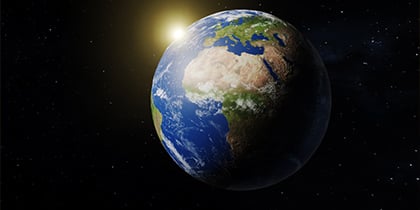Earth Overshoot Day marks the moment when we consume more resources worldwide than the Earth can renew in the same year. In 2025, this day falls as early as July 24. From then on, we consume more than the Earth can restore in that year.
This shift is not new. For decades, Earth Overshoot Day has been shifting ever forward. In this blog, we take you back in time. Where did this trend begin? What social and economic developments were behind it? And how has our use of resources evolved since then?
Where did the shift from Earth Overshoot Day begin?
The shift began in the period after World War II. Many countries were in a phase of reconstruction. Economies were recovering rapidly, employment was increasing and living standards were rising. What began as a recovery turned into a period of growth and consumption beginning in the 1950s.
Technological advances changed daily life. More and more households got refrigerators or telephones. By 1970, over 80% of Dutch households had a TV. Appliances such as washing machines also became more common. What was once luxury became accessible to a large group of people.
At the same time, consumption patterns also changed. Whereas people used to do their shopping at the baker's, butcher's or greengrocer's, from the 1960s supermarkets rapidly gained popularity. Everything was in one place, and products were already ready on the shelf - packaged and priced. Unlike specialty stores, you no longer had to wait for something to be weighed or packed.
In addition, the number of cars on the road doubled between 1960 and 1975. More mobility meant not only more fuel-but also more raw materials to produce the cars themselves-from steel and rubber to plastic and oil. At the same time, due to the baby boom, many new homes were being built. That required additional raw materials such as concrete, wood, glass and metal.
In short: the pressure on natural resources grew - with the result that we consumed more raw materials than the earth could recover in a single year.
Earth Overshoot Day moves further and further away
Over the years, Earth Overshoot Day moved a little further forward almost every year. We'd like to take you through five years that stood out-and what those moments say about how we deal with resources.
1987: Population growth and globalization
In 1983, Earth Overshoot Day fell on December 9. That was the last time this day-the moment when we consume more resources worldwide than the Earth can renew in a year-was still in December. Just four years later, in 1987, Earth Overshoot Day already fell on Oct. 19. A substantial shift in a short time, showing how quickly the pressure on our planet was increasing.
What caused this acceleration? A major factor was strong population growth. On July 11, 1987, the five billionth world citizen was symbolically born-a milestone that became known as Five Billion Day. That growth also meant growth in consumption: more people needing food, energy, housing, transportation and products.
July 11, 1987, the five billionth world citizen was symbolically born-a milestone that became known as Five Billion Day. That growth also meant growth in consumption: more people needing food, energy, housing, transportation and products.
In addition, global industry was growing rapidly. More and more goods were produced in low-wage countries and then shipped worldwide. The globalization of production chains led to an increase in transportation movements, energy consumption and packaging materials-necessary to protect products during transport and storage.
Most production ran on fossil energy -- such as coal, petroleum and natural gas -- and circular solutions were also in their infancy in waste management. Waste was mainly landfilled or incinerated, despite the fact that recycling was already known by then.
2000: New patterns of consumption
In the year 2000, Earth Overshoot Day fell on Sept. 23. That put the day a full month earlier than in 1987 - and more than two months earlier than in 1983, the last year it fell in December. In just two decades, the balance between what the Earth can provide and what we as humanity consume shifted rapidly.
What explains this accelerated shift? At the turn of the millennium, consumption behavior changed worldwide. Fashion chains constantly introduced new collections, making production cycles shorter and more intensive. At the same time, just-in-time logistics became more common. Instead of large stocks in warehouses, products were increasingly delivered precisely on time. This led to more, smaller transport movements - and thus additional emissions, more packaging materials and higher pressure on raw materials.
The way we produced raw materials and food also changed. To meet the growing demand, natural resources were used more and more intensively. For example, pressure on agricultural land increased, including for meat production and animal feed. At the same time, demand for metals and fossil fuels grew, leading to large-scale mining and deforestation.
2015: e-commerce and packaging waste
In 2015, Earth Overshoot Day fell on Aug. 6. That's almost two months earlier than in 2000. Global consumption and production continued to grow-not only in volume, but also in speed.
What particularly stood out during this period? The meteoric rise of e-commerce. Around 2015, the number of online shops grew, with ever faster delivery times and home delivery became the new standard.
Information and offers became increasingly accessible, leading to a faster and continuous flow of purchases. This not only increased sales of electronics, but also the demand for raw materials such as cobalt, lithium and rare earths - materials that are increasingly being mined worldwide.
The rise of e-commerce caused an explosion in packaging waste - from cardboard and plastic to Styrofoam. Online orders generated on average 4.8 times more packaging material than physical purchases with equal spending.
2020: A temporary positive shift
In 2020, Earth Overshoot Day fell on Aug. 22. Remarkable, as a year earlier this day was on July 29. It was the biggest positive shift in years-almost a month later. The cause? The corona pandemic. This brought many industries to a temporary halt. Factories closed, borders closed, air travel was down and millions of people worked or stayed home. The world was running at a slower pace. With it, global resource use also declined.
The shift-one month back from the year before-shows how strongly on our pressures are related to our behavior.
2025: Global Circular Economy Decline
In 2025, Earth Overshoot Day falls on July 24. This again puts the date earlier than in 2024, when the day fell on Aug. 1.
After the temporary slowdown during the corona pandemic, global production and consumption have increased in many sectors. At the same time, the transition to a circular economy has been slower than hoped. Recent figures show that the world is currently only 6.9% circular-a decline from previous years. This is at a time when pressure on resources is increasing, due to economic growth, population growth and climate change. But geopolitical tensions and the availability of raw materials are also affecting this.
To give direction to circular growth, it is important to know how far companies are already with circularity, what steps they are taking and what they are up against. We investigated this among 500 companies in the Netherlands and Belgium.
The insights were surprising and urgent.
Frequently asked questions about Earth Overshoot Day
Earth Overshoot Day is a concept introduced in the 1970s by British researcher Andrew Simms. The first calculations showed that in 1971, humanity consumed more natural resources than the Earth could regenerate in that same year for the first time. Back then, Earth Overshoot Day fell on December 25. Since then, the date has moved earlier each year.
The calculation works as follows:
World biocapacity ÷ Ecological footprint × 365 days = Earth Overshoot Day
Biocapacity refers to the amount of natural resources the Earth can regenerate in a year. This includes, for example, the growth of forests, fish reproduction, and the natural fertility of farmland. It also covers the capacity of ecosystems to absorb CO₂. Forests, for instance, absorb CO₂ through photosynthesis, converting it into oxygen while storing carbon in wood. When deforestation outpaces forest growth, biocapacity declines and more CO₂ remains in the atmosphere.
The ecological footprint is the total amount of resources humanity consumes in a year—such as wood, water, food, and fossil fuels like oil and gas. This footprint is calculated per country, based on consumption patterns and available biocapacity. A country with high consumption and large-scale imports generally has a much larger footprint than a country that relies on local production and uses fewer resources.
The larger the ecological footprint and the smaller the biocapacity, the earlier Earth Overshoot Day falls in the calendar year. This means we are depleting our natural resources faster and giving nature less time to recover.
Earth Overshoot Day marks the date when humanity as a whole uses more resources than the Earth can regenerate in a year. National Overshoot Days show the same concept, but on a country level. They indicate how quickly a country depletes its share of the world’s biocapacity.
If everyone lived like the average person in the Netherlands, Dutch Overshoot Day would have fallen on May 5 this year.
The Circularity Gap represents the gap between our current linear economy and a truly circular one. At present, the world is only 6.9% circular—meaning there is a gap of 93.1%.
The speed at which we consume natural resources and produce waste directly contributes to pushing Earth Overshoot Day earlier in the year. The less we reuse, and the more we rely on virgin materials, the faster we exceed the Earth’s regenerative capacity.
By closing the Circularity Gap—for example, through sustainable design and reusing materials—we can reduce pressure on natural resources and move Earth Overshoot Day further into the future.
Want to learn more? Keep reading.
How do we bring Earth Overshoot Day back to December 31st?
Earth Overshoot Day marks the moment when we consume more resources worldwide than the Earth can replenish in a year. Instead of December 31, this day will fall on July 24 in 2025. How do we turn that tide?
That starts with using raw materials more carefully - or, in other words, the resource transition. This is about changing the way we use raw materials. Instead of consuming raw materials, the goal is to reuse materials. This ensures less waste and a more sustainable use of raw materials.
Op de hoogte blijven
Op de hoogte blijven van alle nieuwe ontwikkelingen? Volg ons op LinkedIn en Instagram of abonneer u op de nieuwsbrief. Bent u nieuwsgierig naar wat Milgro voor uw bedrijfsvoering en afvalproces kan betekenen? Neem dan contact op.












